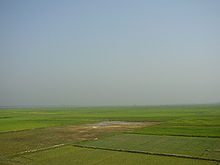|
Hakaluki Haor  Hakaluki Haor (Bengali: হাকালুকি হাওর) is a marsh wetland ecosystem of north-eastern Bangladesh.[1] It is one of Bangladesh's largest and one of Asia's large marsh wetland resources.[citation needed] The haor is bounded by the Kushiara river as well as a part of the Sonai Bardal river to the north, by the Fenchuganj-Kulaura railway to the west and to the south, and by the Kulaura-Beanibazar road the east. It lies between 24°35’ N to 24°44’ N and 92°00’ E to 92°08’ E.[2] A total of 558 species of animals and birds have been identified here, including some very rare – already declared as threatened, vulnerable, endangered and critically endangered species. Some 190,000 people live in the surrounding Hakaluki haor area. Hakaluki Haor is designated an Ecologically Critical Area (ECA).[3] The surface area of Hakaluki Haor is 181.15 km2, of which 72.46 km2 (40.01%) is within the territory of Barlekha Upazila. It is also under Kulaura and Juri upazila of Moulvibazar District and Golapganj, Fenchuganj upazila of Sylhet district.[1] See alsoReferences
|